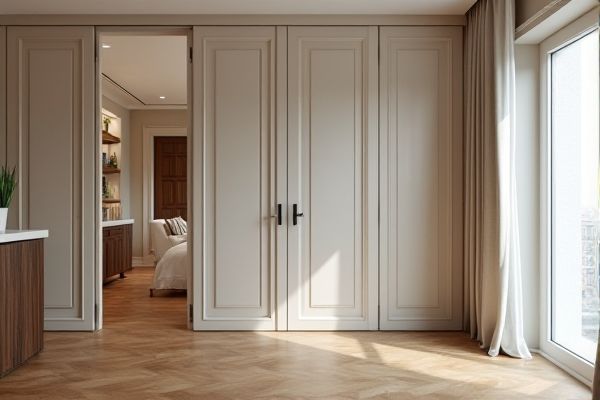
Movable partitions offer flexible space management by allowing areas to be reconfigured easily, whereas fixed partitions provide permanent, stable divisions ideal for long-term layout structures. Explore the rest of this article to understand how your choice between movable and fixed partitions can impact functionality and design in your space.
Table of Comparison
| Feature | Movable Partition | Fixed Partition |
|---|---|---|
| Definition | Partitions that can be repositioned or removed to modify space layout. | Permanent walls or dividers fixed in place, defining static spaces. |
| Flexibility | High flexibility; easy to reconfigure rooms or areas. | Low flexibility; spaces remain constant unless rebuilt. |
| Installation | Quick and less invasive installation process. | Requires extensive construction and time. |
| Cost | Typically lower upfront and modification costs. | Higher initial construction costs. |
| Durability | Generally less durable; suitable for temporary use. | Very durable and designed for long-term use. |
| Acoustic Properties | Moderate sound insulation depending on materials. | Superior soundproofing and privacy. |
| Design Variety | Wide range of materials and styles available. | Limited to permanent wall finishes and structures. |
| Use Case | Ideal for flexible office spaces, exhibitions, and events. | Best for permanent room divisions and structural spaces. |
Introduction to Movable and Fixed Partitions
Movable partitions dynamically allocate memory by resizing or relocating partitions during runtime, enhancing flexibility in resource management for systems with varying workloads. Fixed partitions allocate predetermined, unchanging sections of memory that simplify management but may lead to inefficiencies like internal fragmentation. Understanding the distinctions between movable and fixed partitions is crucial for optimizing memory utilization and system performance in operating environments.
Definition and Key Features of Movable Partitions
Movable partitions are flexible room dividers designed to create adaptable spaces by easily being repositioned or removed without permanent installation. Key features include lightweight construction, sound insulation properties, and modular design that allows customization of size and layout. These partitions offer quick reconfiguration options, enhancing space utilization in offices, conference rooms, and commercial environments.
Definition and Key Features of Fixed Partitions
Fixed partitions are predetermined segments of memory with a constant size, allocated before program execution begins. Each partition holds exactly one process, simplifying memory management but often leading to inefficient space utilization due to internal fragmentation. Your system benefits from predictable performance and reduced overhead, though flexibility is limited compared to movable partitions.
Space Flexibility: Movable vs Fixed Partitions
Movable partitions provide superior space flexibility by allowing rooms to be reconfigured quickly to accommodate varying needs, making them ideal for dynamic office layouts and event spaces. Fixed partitions offer limited space adaptability because their permanent installation restricts changes, resulting in more rigid and predefined room configurations. The ability to easily adjust movable partitions enhances efficient use of floor space and supports multifunctional environments.
Installation Process and Time Comparison
Movable partitions offer a quick and flexible installation process, often completed within hours due to their modular design and minimal structural requirements. Fixed partitions require a longer installation time, involving construction, drywalling, and finishing, which can span several days or weeks depending on the complexity. The ease of relocation and reconfiguration makes movable partitions ideal for dynamic office environments seeking minimal downtime.
Cost Analysis: Movable vs Fixed Partitions
Movable partitions typically incur higher upfront costs due to the engineering and materials needed for flexibility and durability, whereas fixed partitions often involve lower installation expenses but higher modification costs over time. Maintenance expenses for movable partitions can be lower long-term as they allow easy space reconfiguration without major structural changes, while fixed partitions may require more extensive renovations when altering layouts. Cost-efficiency depends on the frequency of space adjustments, with movable partitions favored in dynamic environments and fixed partitions suitable for static layouts.
Aesthetic and Design Options
Movable partitions offer versatile aesthetic and design options with customizable materials, finishes, and configurations that can adapt to changing interior layouts and styles. Fixed partitions typically provide a more permanent, uniform look with limited flexibility but allow for integrated design elements like built-in storage or soundproofing features. The choice between movable and fixed partitions depends on balancing design adaptability with the desired permanence and architectural intent.
Acoustic Performance and Privacy
Movable partitions offer enhanced acoustic performance by utilizing sound-dampening materials and seals, effectively reducing noise transmission compared to fixed partitions. Your privacy benefits from the flexibility of movable partitions, allowing adjustable space configurations that can isolate conversations and activities as needed. Fixed partitions provide consistent sound insulation but lack the adaptability to modify acoustic environments, making movable partitions preferable for dynamic privacy control.
Maintenance and Durability Considerations
Movable partitions offer easier maintenance due to their modular design, allowing individual sections to be repaired or replaced without affecting the entire structure. Fixed partitions provide superior durability with robust materials and permanent installation, minimizing wear and tear over time. Choosing between the two depends on the balance between the need for flexibility in space management and long-term structural resilience.
Choosing the Right Partition for Your Needs
Selecting between movable and fixed partitions depends on space flexibility requirements and budget constraints. Movable partitions offer adaptability for frequently changing layouts, enhancing collaboration and space efficiency in offices or event venues. Fixed partitions provide permanent, sturdy divisions ideal for privacy, security, and long-term space configuration in residential or commercial settings.
 homyna.com
homyna.com